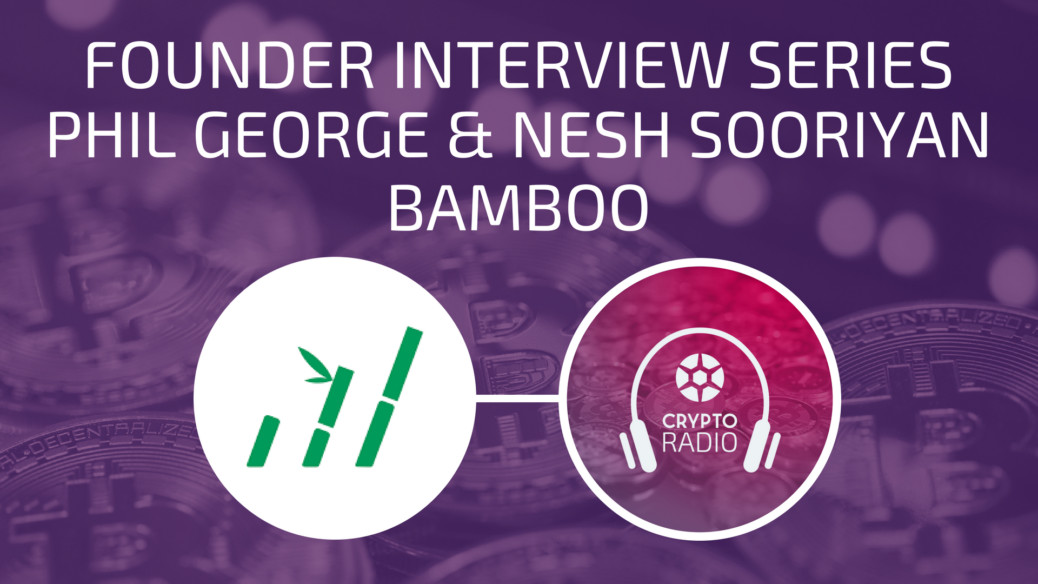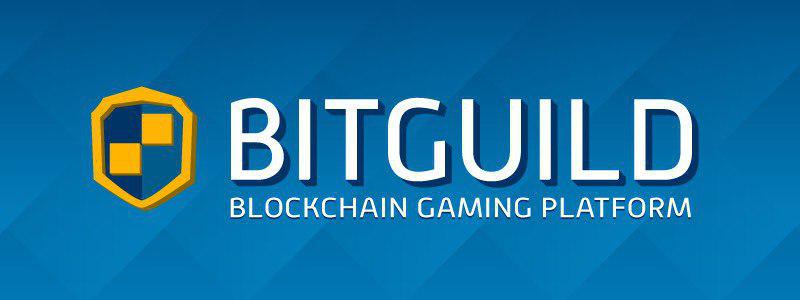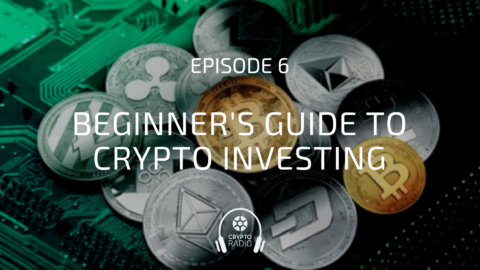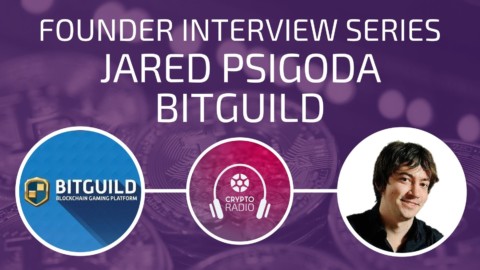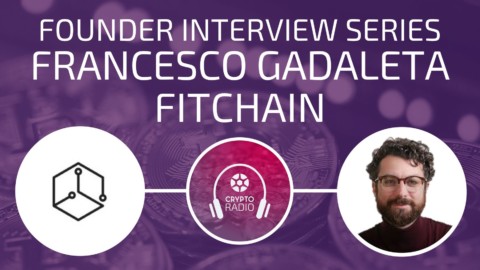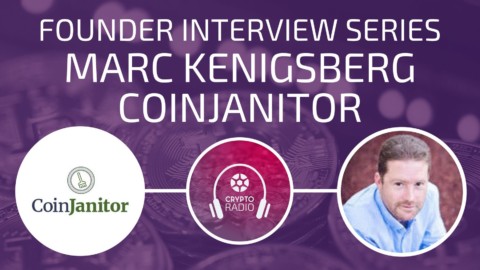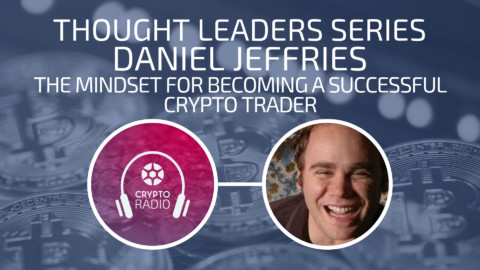Podcast: Play in new window | Download
Euvie: Hi crypto world. I’m Euvie Ivanova and today on the founders series we have Phil George and Nesh Sooriyan, the founders of Bamboo. Bamboo is a mobile application and a micro-investment platform that enables people to buy crypto assets [00:01:00] like Bitcoin in under a minute, using just their bank account and a mobile phone. The idea is to start small and invest spare change from daily purchases into cryptocurrencies. The app is mean to be assessable to the average person, not just crypto geeks.
To get all the show notes and links from this episode go to cryptoradio.io/bamboo. This episode is brought to you by bitguild.io. Bitguild is a new gaming platform built using blockchain technology. Their mission is to redefine the relationship [00:01:30] between gamers and game developers. On the Bitguild platform gamers maintain full ownership and control of their virtual items, which are stored on the blockchain. They can transfer items and progress between compatible games and they can make in-game transactions safely and cheaply, and sometimes free.
Developers who join the platform will get a direct link to an established player base, a strong community, and a network of likeminded developers building on the same platform. Developers will also have the potential for direct game development funding from Bitguild. [00:02:00] Bitguild just completed their token sale on April 5th 2018 in which they raised 35,000 Eth or just over 13 million USD at the current market rate. If you want to find out more, go to cryptoradio.io/bitguild. Alright guys, welcome to the show.
Phil: Thank you.
Nesh: Thanks for having us.
Euvie: Let’s start with your elevator pitch.
Phil: [00:02:30] We are Bamboo, we are building an application which makes it easy for anyone to quickly and easily get involved in cryptocurrency, being able to buy crypto assets in under a minute with nothing but a bank account and a mobile phone.
Euvie: Tell us a bit about how you started this project and why did you choose this industry, what’s exciting about it.
Phil: I guess both Nesh and I realized the problems with the current industry at the same time. Nesh and I can both talk to the story [00:03:00] because where we were sitting in Los Angeles at the time. Basically, about a year ago we both got reminded about cryptocurrency and both of us have a past with cryptocurrencies that both of us can talk to. A number of things had come together that we found ourselves sitting at Bulletproof Coffee in Los Angeles trying to find all of our wallets from various cryptocurrencies that we’d had over the last few years and figure out where we were and what we had. How long did we spend Nesh, six hours? Something like that.
Nesh: [00:03:30] Yeah, it was an interesting story there where we walked in and we were like, “Okay, we need to have our brains in an optimal state.” We were fasting. We had a Bulletproof coffee with all the additional shots and then just sat there with our laptops for six hours.
Phil: Trying to find all of our various cryptocurrencies. We came to the end of it, we’d found most of it, we accepted the loss of some of it. We were obviously pretty happy that we had had exposure to it early on. But the overwhelming sense that we were left with [00:04:00] is that if this took us, people who spend every day deep in tech, understanding tech, six hours just to figure out what’s going on, how reasonable is it to expect the average person or just people who aren’t pretty familiar with tech to get involved? How can we make it easier for them to get involved so that we can keep growing the entirety of the blockchain ecosystem?
I guess the most exciting thing is that at the moment cryptocurrency, the community, the blockchain community, is still a pretty small community. We’ve got blockchain week coming up [00:04:30] next week in New York and obviously that’s a really big event. But sometimes it feels like the whole world is already into blockchain. In actuality, there was a report that come out a few weeks ago where there was less than 10 million people that have even interacted with cryptocurrency. I think the most aggressive numbers have been 18 million. Out of seven and a half billion people, that’s just not enough. What we’re excited about is introducing new people to the blockchain ecosystem and getting them involved so that they can start helping and solving [00:05:00] problems that need solving.
Nesh: We wanted to make it super easy so the average user doesn’t need to understand how HTTPS works, they don’t need to understand DNS, but they’re able to interact and it is able to further their lives. When we sat down, we were like, “That needs to happen in blockchain.” It isn’t that we’re not getting great technological breakthroughs, that is happening. What is becoming the larger gap is the distance between those great technological breakthroughs and interpreting that and translating that for the every day user. [00:05:30] We need to be bringing in the mothers, the fathers, the students, the electrician, it needs to be very simple for them to get involved. That’s where we started working on Bamboo.
Euvie: Yeah, that’s a really good point because people who’ve been in the blockchain space for a few years, we’re used to it being this clunky, geeky thing that you have to know the particulars of to figure out what to do. How to store your private keys, copy and paste this HEX address. We don’t realize that most people don’t [00:06:00] operate like that, that might be too technical for them or too scary or too confusing. Yeah, creating tools that are accessible to the average person is really important if we want to see adoption past a few million people using this.
Nesh: Yeah, you’re 100 percent right Euvie. We are going to drop the cost base and we are going to decentralize power structures. But with that comes immense about of responsibility to teach the end user about the requirements for security and what this means for them and make it as easy as possible for them to get involved. The last thing we want to see [00:06:30] is a revolution of sorts where we are the ones driving cars and we turn around and we see our loved ones and they’re essentially in a horse and cart or walking, which is what could happen.
Euvie: Yeah, super important stuff. Do you guys have competitors in this space? What are they doing and what makes you different from them?
Phil: Yeah, the main thing that our product is doing is taking a proven concept that we’ve seen work in the share market, with companies like Acorns and Stash, who have [00:07:00] proven that a roundups model or a spare change model – which is the primary function of our platform – is a really attractive and enticing method of saving. Micro-investment is the term that’s arisen. Except, with the share market it’s not particularly exciting and there’s nowhere near as many possibilities involved with the share market as what we’re seeing rise out of the blockchain ecosystem.
In terms of competitors, yeah, we have competitors in the traditional space, in the share market, [00:07:30] but in terms of an application which effortlessly allows people to use their spare change and small manual contributions in a recurring basis and automatically buy a collection of cryptocurrencies. There is anyone doing that, that exact functions. We’re seeing Coinbase, which everyone’s heard of I’m sure on this podcast. They’re a mobile exchange. We’ve seen Robbin Hood recently has added easy purchasing of cryptocurrencies, [00:08:00] but no one’s using this micro-investment strategy with cryptocurrencies and making it effortless to get involved.
Nesh: Walking you through I guess the game changer that we see. Traditionally, what we’d seen is you obviously get registered on an exchange. Let’s go from the point when you get excited about cryptos. Your everyday user hears about cryptos, they ask their friend, “Hey, how do I get involved?” Then that activation energy that they have as a user needs to last them for a journey that ends up with them holding this asset. [00:08:30] At the moment, they need to go and get exchange verification, which could take a number of hours, if not days at peak time. Then you have Fiat interbank transfers. You could be waiting days or weeks before you purchase your actual crypto assets.
That is a long time to have an activation energy sustain itself. Whereas, what we’re seeing with the Bamboo application, even in our early prototype, we’re able to shortcut that process down to about 46 seconds. From the moment a person downloads the app to [00:09:00] buying as little as one dollar in crypto assets.
Euvie: How does that work? Obviously, it has to be integrated with a traditional banking system somehow. Are people buying it with a credit card or PayPal or what’s the API?
Phil: The good thing is that because of recent changes to banking systems around the world and the speed at which you can actually transact with bank payments, we’ve got a lot more ability to have a solution like this than we had just a few years ago. [00:09:30] Put simply, by the user providing Bamboo with a tokenized access to the bank account, we are able to make the equivalent of things like direct deposits or sometimes they’re referred to as ACH transfers from the user’s bank account to Bamboo’s platform, which happens basically instantaneously in most of our launch markets.
That also means that because of the fact that the users provided the bank account, we don’t have the same KYC or AML requirements [00:10:00] that typically would be required of a typical exchange. This both helps us with us onboarding users easily and helps the user because they don’t have to jump through so many hoops.
Euvie: How far along are you guys in this tech right now? Is the app already ready or is it being built?
Phil: Yeah, the app’s currently being built. Obviously, not on the app store just yet. We are currently building the app at the moment and we have alpha prototypes running in house at the moment. The back-end platform that [00:10:30] does the automation of the purchases of the crypto assets is also functional but not publicly accessible.
Euvie: What is your roadmap look like for the next, say, 6 to 12 months?
Phil: Our road map is basically trying to get to as many markets as possible, as quickly as possible. I think Nesh has mentioned earlier, we were recently up at Seoul and our initial launch markets are Australia and then launching into selected states in the United States, then going into Europe. [00:11:00] In Korea, when we were meeting with people who were helping us out and supporters of our project, they were just insistent that we come up to Korea. Most of our roadmap for the next 6 to 12 months actually is just launching in as many launch markets as we can once we’ve got the one out in the Q3 of 2018 calendar year.
Euvie: Nice. You guys are partnering with different banking partners in each region?
Phil: Awesome question. I think the best way to think of it is the platforms and technology platforms that we’re using [00:11:30] give us access to the majority of user’s bank accounts in our launch markets without us needing to partner directly with the banks. We’re using similar technologies that you see the likes of Acorns and Robbin Hood and Stash using to access user bank accounts and enable us to do those quick deposits and withdrawals that we see in modern Finn tech apps that you’ve seen on the app store. We can use those same technologies, we don’t necessarily need to partner directly with the banks.
Euvie: Cool.
Phil: [00:12:00] It makes it a lot easier, a lot less leg work.
Euvie: What are some of the specific things you guys are planning for the next year? What are some of the key milestones and also challenges that will determine whether you’re succeeding?
Nesh: We have the Australian launch market, which will closely be followed by the six states in the US that we will launch with.
Phil: I think that’s up to 10 now.
Nesh: Up to 10, yes. That’s correct, as of just a few hours ago. [00:12:30] That’s probably the larger chunk of what we’re after. I think Korea has predominantly been our partners and pushed Korea more and more. We may see ourselves in Asia sooner rather than later. It’s all about a growth game for us. This is about mass market adoption of crypto. For us, those launch markets, the success in those launch markets, will determine whether this project is a success. Also, being a utility token, the number of downloads and people that are connecting with the application drives demand [00:13:00] for the utility token, as well.
Phil: In terms of product roadmap, though, I guess the best thing that we can talk to is the initial version is designed it to make it as easy as possible for users to get a simple strategy on the app to be purchasing cryptocurrencies quickly. Then future versions are concentrating around empowering the user to adjust as many things as possible with how their actually portfolio is broken down, then making that [00:13:30] social so that you can share the structure of what you’re doing with other people.
We’re trying to be mindful of the fact that a lot of our users won’t necessarily have a huge amount of knowledge about the blockchain technologies that they’re investing in through their crypto assets. Over time, we’ll be able to help those people become more familiar with those thing and get educated about the technologies. Then they should be empowered to make choices about what they want to be investing in. If someone believes in a certain technology over another, [00:14:00] their ability to choose those technologies and share those selections with their friends will increase over time as we iterate on version after version.
Euvie: Can you tell me about how you select the proportions of all the different cryptocurrencies and how you choose to rebalance? Or are you using an external API for that?
Phil: We are doing that in house. It’s mostly simply defined or described as the top five cryptocurrencies determined by market cap, then we passively rebalance these [00:14:30] monthly. At the moment, it’s monthly. It will be assessing what’s the most effective using back testing, but it’s a generalist approach to maximizing someone’s exposure to the various technologies that are defining the ecosystem and over time we think that what will be in the top five will change, so we want our users to always have exposure to the things that are at the top of the market.
Euvie: Yeah, it’s interesting. I’ve seen this model with a few things recently, like Crypto 20 is doing pretty good and they’re doing the top 20 [00:15:00] and they’re manually rebalancing based on what is going up and what’s going down, different indicators. It’s an interesting model for sure.
Phil: Yeah, we like the Crypto 20 model. We actual reference Crypto 20 in our white paper. We think that they did a lot of good work in structuring how they’re doing their investment. We wanted a similar approach that’s slightly simpler, understanding that our user base is a slightly different user base. Obviously with Crypt 20, it’s amazing but it’s only really [00:15:30] accessible to people who understand crypto, which is why we have a different onboarding platform.
Euvie: Actually, one thing that they did really well is the user experience portal. Everything was so seamless and so simple and really well designed. I think you guys are also focusing on that, how to make it easy for the user so they don’t have to try to figure out some technicalities. It’s just right there, the instructions are simple. I love the focus on that, I think there needs to be more of that in the crypto space.
Nesh: [00:16:00] Yeah, we joke about it. I think we were gifted with a pretty talented and driven core team. In terms of UIUS, very early on the piece our product designer, a guy called Linus Extrum, who was one of the early employees at Type Form and then later went onto work on File Coin with Protocol Labs. This guy’s mind is just all about how do we onboard people in the simplest manner? How do we build designs that resonate with people’s inherent [00:16:30] desires and what they want to accomplish? Linus most recently was joined by our head of production, Will Griffiths, who came from Virtual Gaming Worlds, which is a company that’s now hyper scale making consumer gaming applications. However, he’s also had 5 top 10 apps in the last 7 years. It’s a team that, from the top, is lead by simplicity but beauty and design.
Euvie: Cool. Yeah, speaking of your team, how do you guys [00:17:00] all know each other?
Nesh: That’s a great question. Some of our team have known each for in excess of 15 years. It’s been quite interesting because we’ve all watched each other from afar and been quite lucky to be around driven people. The opportunity arose for us all to work with each other and we were like, “We were too young to be part of the initial internet boom and we feel as though blockchain is that next revelation,” and we didn’t want to give up that opportunity. Phil will be able to give you some details on him and Pete and Simone.
Phil: [00:17:30] Yeah, in terms of the founding team, Peter and I actually went to high school together and started our first business in high school, which was actually doing web design when web design was still an unsolved problem in around 2000. We actually started our first business then, went to uni together, continued to work together intermittently through our 20s on various projects. Got our first jobs at a company together where we met the other founder, Simone. She was the [00:18:00] talent manager, I think her position there was global manager talent, which she’ll kill me for mentioning online. That was her role.
We ended up forging this friendship with Simone, who looked out for us when we were the two youngest people in the company doing crazy things. She would always make sure that we were looked out for and looked after. We continue to have that friendship and then a few years later met a Nesh, who was running a food tech company at the time called Paleo Meals Direct, [00:18:30] which was amazing, an awesome company. I had been ordering these meals that were being delivered to me, like grass fed beef, premade meals, so that I could just work and eat good food.
Nesh used to do this day where people could come and pick up food from his delivery centres and he would meet them and ask questions and get feedback. He asked me some questions, I gave him probably a little bit too much feedback and then we ended up becoming friends. Then Nesh was running a program called [00:19:00] Plus Eight, which was like a… How do you describe it? A start up incubator Nesh?
Nesh: Yeah. It’s a later stage accelerator for companies past the ideation phase and into their first seed round.
Phil: Nesh reached out and asked me come on board as a mentor there and we worked together on that project last year, which is what saw us end up in Los Angeles, because we’d flown over with the cohort up to the valley to speak to investors and growth hackers and things to give the cohort exposure to what’s going on over there. That’s how this whole idea came about.
Euvie: [00:19:30] Cool, can you tell me some of your guy’s advisers and how deeply are they involved, who are they?
Phil: Yeah, sure thing. We’ve got a few advisers at the moment. We’re about to bring on another adviser but I don’t think we can mention that just yet. The people we’ve brought on so far have really been helping us with what we think are some of the most critical aspects. We’ve got Gavin [inaudible [0:19:52], who’s ex HSBC and worked on HSBCs anti money laundering board, I think it was, helping us with [00:20:00] navigating international jurisdictions and legislations around cryptocurrencies and our requirements from a licensing and regulation perspective.
He’s been valuable in helping us structure the company the right way and understand what our responsibilities are in all of the different markets that we want to launch in. He’s our banking and regulations expert. We speak to him a few times every week. He saves us months and months of learning in every phone call, [00:20:30] which is great. We’ve also got Harrison, Harrison who is from Uber, currently working at Uber Eats or heading up Uber Eats in Mexico I believe. I was just on the phone to him yesterday, had a big catch up with him. He’s coming back to Perth or back to Australia soon, that’ll be good. We speak to him about our growth approach, because obviously Uber is a very consumer centric set of tools.
We try to get a good understanding of what they’re seeing in the market from a user growth and demand perspective, [00:21:00] take some of those lessons learned and apply them to our own application. I think there would probably be a lot of overlap in the people who use something like Uber, which is, even though it’s a car app or a food app, it’s really people interacting financially with their phones for convenience. In that respect, there’s a lot of overlap in what we need to do. Again, Harro’s just amazing at understanding growth and what people want and look for. He’s been very valuable.
Our other adviser that we’ve got in our white paper, [00:21:30] Simon, Simon Newton, he’s ex-Google and now at Uber I believe. He’s a security guru. I don’t have a whole heap to do with him, because you more works with the DEV team, but he’s just one of those guys who just has a brain the size of the universe when it comes to security and thinks about everything possible. Which is obviously really important when we’re building an application like the one that we’re building.
Euvie: Yeah, I like your point about that your user base is similar to that of Uber, I think that’s a really interesting point. Lots of people in the crypto space don’t think about it that way but you’re thinking about [00:22:00] how people are using product, rather than, “It’s about crypto or it’s about finance.” You’re thinking about maybe the way that they’re interacting with the phone or the times that they’re doing it. It’s a really good point actually. I just haven’t heard it framed that way before, but it totally makes sense.
Phil: Yeah, it’s been funny. When we’ve been on this journey, some of the people who are the most passionate about crypto, they at first don’t necessarily understand the problem that we’re trying to solve. Because even though it is complex [00:22:30] and frustrating, we’ve got some people making it simpler with Exodus Wallet and multi-currency wallets and things. They’re so used to the complexity that they don’t see it as a barrier to entry anymore, because they’re in it and they’ve got all the belief.
They sort of say, “Well, why do you need to do this, because we’ve already got Coinbase.” Or, “I’ve got the [inaudible [0:22:47] app on my phone.” They’ve forgotten just how complex those apps actually are to use and then do something with, like pay someone or actually function. Sometimes the true crypto believers that have been in it for the longest, [00:23:00] don’t see the need for this app. Whereas, the people who aren’t in it are the ones that are saying, “When is the app going to launch?”
Euvie: Yeah. Alright, what are some of the partnerships that you guys have in place?
Nesh: That’s a great question, Euvie. Our early participants that came in in the pre-sale, prior to the white paper and prior to the prototype were a group called digital capital management, out of Australia. They brought in another adviser who was [inaudible [0:23:28] partners out of Singapore. [00:23:30] Most recently, have been joined by Digital X, which is one of the world’s first listed digital funds and corporate advisories on a stock exchange.
They’re listed on the Australian stock exchange and they were one of the partners that were behind Power Ledger and, most recently, [inaudible [0:23:48] they helped and also Chevon. Those are our three key partners in that space. In Switzerland, we work with KPMG Switzerland. In the US, our legal advisor and compliance [00:24:00] advisor is a firm called Reed Smith.
Euvie: Speaking of that, what are you guy’s marketing plans for the project?
Nesh: We’ll be launching in Australia and the US. At present, we have a cost for acquisition with some of our ad sets and content that is [inaudible [0:24:18], which is good. We should see that scale in future. I thin the larger play here and what we’re really excited about isn’t necessarily our direct marketing or our content, but it is the [00:24:30] network distribution of the token. It is in circulation at the moment with some of the private token participants. We have a token distribution that is assigned similar to an airdrop but not an airdrop.
What we’ll be doing is we’ll be rewarding users within the app for behaviours that benefit the network. Those behaviours are you’ll receive Bam tokens obviously for completing the onboarding process, connecting your bank account. You will receive Bam tokens for achieving [00:25:00] milestones for your contributions. And you will receive Bam tokens for bringing other people onto the platform, that’s what we’re most excited about within our launch markets.
It is having seen the way that airdrops have worked for companies like Poly Math and Ontology. We’re very excited to see people that are early adopters get onboard the platform and drive that initial level of virality. Hopefully, fingers crossed, everything leads towards hyper growth alongside our paid acquisition and also [00:25:30] our content marketing.
Phil: I’ll just add one thing to the point around user acquisition and growth. Again, referencing Uber style apps where you may have seen ‘give five get five,’ or ‘refer your friends and they get a free trip and you get a $20 credit on Uber,’ or something like that. Not sure if you’ve ever seen those but they’ve been singlehandedly the most effective campaigns to grow out platforms. Air BnB have used it to give you a $30 travel credit when you invite [00:26:00] friends and they book an Air BnB. Part of the network distribution is really to say to our initial userbase, who will probably be people who have a little bit better exposure to crypto. They’ll be inviting all of their friends and family who don’t and they’ll be incentivized with Bam tokens.
We think that that’s attractive to everyone, because our token being a utility payment token means that they’re in essence offering access to the platform at a discounted rate to their friends and they themselves [00:26:30] get the discount using the platform. We want to take that same success that we’ve seen on platforms like Uber and Air BnB and apply it for our growth model.
Euvie: Yeah, that’s a great use of gamification. When you see something that works, there’s no need to reinvent the wheel, you can just apply the same strategy. That’s awesome.
Phil: Exactly.
Euvie: Is it an ERC20 token?
Phil: Yeah, ERC2023.
Euvie: Alright. Let’s talk about your private presale. Are you guys doing a private presale?
Phil: Yes. We’re doing a private sale in its entirety at this point in time.
Euvie: Okay, [00:27:00] there’s not going to be a public offering?
Phil: The jury is still out on that one. We, at the moment, are seeing huge amount of interest through our private avenues. We think that there’s definitely benefits to going both directions. That may change but at the moment we are still figuring out whether or not we’ll do a public and what that would look like.
Euvie: Okay. Let’s talk about your plan to spend the capital.
Phil: Yeah, sure thing. One of the excellent things about our company [00:27:30] being a Swiss based company is that when you work with regulators and when you work with countries that are actually proactively looking at cryptocurrency projects and blockchain projects, you get the opportunity to work with them on what that looks like. One of the things that you do with Switzerland is, working with regulators, you build out a four- or a five-year budget and a business plan which shows where your costs are going to be going and your expenditures to [00:28:00] grow into the various markets you want to grow in.
Then you can actually engage with them on what that looks like from a tax and legal perspective. One of the big benefits of that is that we now have a very well-articulated plan for where that capital’s going over the next literally five years. We haven’t really just pulled a number out of a hat and said that that sounds fair. We’ve looked at comparable companies that have attempted to launch in comparable markets and said, “What do we think that we’ll need in order to [00:28:30] reach critical mass and access the markets that we need to launch in in the next five years?”
What does that look like? That looks like a huge amount spent on user acquisition, which is both traditional and digital style marketing, as well as those referral programs. Which obviously costs money. If you’re giving people things in order to acquire users, there is a cost to the business. On top of that we’ve obviously got product, substantial product allocation for building out product and building out our DEV teams. I think, [00:29:00] unlike a lot of the projects that we see in the crypto space, we do have a substantial amount of the budget allocated to the appropriate licenses, legislation, regulation, and legal structures in order to operate well within the current structures of the legal systems and the markets that we want to launch in.
I think that that’s a pretty substantial cost compared to other projects that we’ve seen in the space, which is good. I think that if you want to build a platform like what we’re building and have it last and be there and establish the trust that we need to [00:29:30] establish with our users, it’s important that we do that right from the beginning.
Euvie: Yeah, for sure. That’s a really great point. I think we’re moving from that wild west time in the blockchain space, where anything goes and people don’t really think about regulation too much. Now, that’s becoming less and less possible and also less smart. I’m really glad to hear that you guys are setting up the proper structures and making it actually something that can last 5, 10, 20 years and more.
Phil: [00:30:00] Yeah. I think, almost in defence of some of those projects, some of them that are pure crypto that don’t necessarily interact with the traditional world in any way, shape, or form, pure tech crypto projects maybe they didn’t need to have such a diligent approach, because they’re not the catalyst or the intersect between the traditional market and the new world of the blockchain economy. But for a project like ours, it was absolutely necessary to do it the right way from [00:30:30] day one. I think that moving forward that is what differentiates us from anyone else in our immediate spaces that we’ve taken this very seriously and very diligently to ensure that we have all of the…
For example, we’ve engaged with three different law firms across three different continents to have legal opinion of our ability to launch our product in their markets and we haven’t even launched our first product or even completed our token sale – and we already have that confidence in three different continents.
Euvie: For sure. Is there [00:31:00] a vesting period for the founding tokens?
Nesh: Founders have a vesting period of one year on the token, then we have four-year vesting with a product release cliff on an equity. That came from traditional technology start ups where we want everyone incentivized to that successful product release, then the long-term success of the product itself in the market.
Euvie: Do you have any restrictions on who can buy the tokens?
Phil: Yeah. At the moment, [00:31:30] because we’re running a private sale, we are really only open to sophisticated crypto participants, people who have participated in token sales before and private token sales. We’re working with participants across Asia, across Europe. We are not taking any participations from unsophisticated participants and from the countries that you see exploited from most of the token sales at the moment.
Euvie: Like United States and North Korea? It’s funny how those end up [00:32:00] in the same budget.
Phil: Yeah, North Korea might change though. We were actually up there the day Armistice. Things could change. It could change for all of them. We’re always looking at different ways that we can get as many countries included and participating as possible. Typically, we only exclude somewhere if we absolutely have to. We’re hoping that we can change that and we can get more participation from those places.
Nesh: As Phil said before, I think our approach has been that regulation is coming [00:32:30] and we need to position the organization and structure it so that when regulation does come we can be a somewhat of a gold standard as to how a project should have been structured from the start.
Euvie: Alright. What are some of the important dates for your private sale?
Phil: The private sale is currently underway. If people are sophisticated crypto participators in private sales we encourage them to reach out on our website. People can currently register for a white list where they layout [00:33:00] their interest that the volume of participation that they’re keen in taking. We’re reaching out to selected groups and parties for that. That’s running currently and we intend to close the token sale at the end of June. We’re heading up to consensus next week.
We’ll be there, if anyone wants to reach out to meet up there we encourage them to do so. The product is scheduled to be released in Q3 of 2018, like we said before, and that’s in our initial launch market of Australia. [00:33:30] There’s lots of information on our primer and on our website through our white paper. If people want more information, they have our contact details through the white paper on the website.
Euvie: Do you guys have a hard cap?
Phil: Yes. The hard cap is 20 million US dollars.
Euvie: When are the tokens distributed to the participants?
Phil: They’re distributed approximately upon the launch of the app but prior to, because the app it runs through utility token, so that token needs to have been distributed prior to. [00:34:00] We’re trying to make those two events as close as possible.
Euvie: Let’s talk about you guy’s revenue model in a bit more detail. Once the app is up and running, how is it going to make money?
Phil: Sure thing. The fee structures are laid out in the white paper but, to summarize, we charge a percentage fee of the amount that the user has within their portfolio per month, which is a few for the services that we’ve provided of analysing transactions, [00:34:30] rounding up spare change, transferring it into our platform automatically, and then purchasing a collection of cryptocurrency assets as they’d instructed us to do so on their behalf. At the moment, that looks like a .5 percent fee per month of the amount that’s held by the user. If the user’s got $100 sitting in their account, they’ll get charged 50 cents. That fee will be levied in Bam tokens.
If the Bam token’s valued at 25 cents, say, then we’ll charge to Bam tokens for that fee. [00:35:00] Obviously, as the number of users on the platform grows, the demand for the Bam token grows, but so to as the user’s portfolios grow in size the demand for the Bam token grows in volume. Those two things will be occurring hand in hand.
Euvie: Is the monthly payment going to be automatically in Bam tokens, or will the users be able to choose if they want it in some other currency or Bam tokens? Like [inaudible [0:35:27], for example, I’m just thinking as a reference.
Phil: [00:35:30] At this stage, most likely automatically be in Bam tokens, but it’s important to remember that the Bam token is purchased automatically through the app, because that’s exactly the function of our application. The user can, if they want, go on market and buy Bam tokens and deposit them, but if they don’t want to we can automatically purchase those tokens upon the need for payment of our platform if the user instructs us to do so. That’ll look like the [inaudible [0:35:57] on or off, but rather than having to hold [00:36:00] BNB tokens in your wallet and manually go out and buy them, we’ll automatically buy them whenever it comes time to pay your fees and pay that.
Which means we’ll have this constant and unwavering demand for our token across the platform. It’s funny you mentioned the BND token, because we’re all heavily influenced by that token and big fans of what the team over in [inaudible [0:36:18] are doing, especially what they did with BNB.
Euvie: Yeah, it’s always really good to see who’s already doing it well and just learn from that, no need to reinvent the wheel.
Phil: [00:36:30] Yeah, we saw a report I think it was around mid-April as the market had been in a steep decline for months upon months and the BNB token was the top performing token over that time period because, regardless of the downward or upward market, the BNB token continued to have ongoing demand. That actually held up the BNB token a lot better than a lot of the other tokens that we see.
Euvie: Yeah. Alright, let’s finish up with a quick pitch. Why should people get involved?
Phil: We think that everyone should get involved. [00:37:00] We think that even if you’re a crypto familiar and you’ve been in the space for years, we’re providing technically complex and time-consuming tasks like dollar cost averaging and distributed investment approaches to you without you having to spend time, sit there spending your Saturday rebalancing your portfolios. All the way from the experienced cryptocurrency down to the mum and dad or someone who doesn’t really have the time or inclination to follow the market and spend every waking moment [00:37:30] on Coin Market Cap or any of the new ones popping up and just want to have a little bit of exposure with their spare change, so that at the end of the year they might have $500 or $1,000 USD worth of exposure in what we believe is an asset class which represents the future of trade and technology for everyone. That’s why everyone should use it.
Euvie: Thanks so much for joining us guys, it’s been a pleasure.
Nesh: Thank you.
Phil: Thank you for having us.
Phil George and Nesh Sooriyan explain how Bamboo enables average people to buy crypto assets quickly and easily.
Bamboo is a mobile application and a microinvestments platform that enables people to buy crypto assets like Bitcoin in under a minute, using their bank account and a mobile phone. The idea is to start small and round up the spare change from recent transactions, and invest it in cryptocurrencies. The app is meant to be accessible to the average person, not just crypto geeks. Phil George and Nesh Sooriyan explain how Bamboo uses the gamified models of successful applications like Uber or AirBnb to incentivize users to invite other, less experienced users onto the platform. This way they aim to educate users and raise awareness of the blockchain technology, as well reduce the barriers for participation in the ecosystem.
BAM Token and Token Sale
Bamboo Tokens (BAM) are utility tokens built on the Ethereum blockchain. They are needed to access the Bamboo platform and serve as units to pay the fees for using the platform. The users can also freely transact the tokens, and store them in any ERC20 compatible wallet.
The private sale of BAM tokens is currently underway and is planned to last until the end of June 2018. The goal is to reach the hard cap of 20 million USD. A public sale is not planned at this point, but anyone interested in purchasing the tokens can register on the Whitelist.
Roadmap and Partnerships
The launch of the first version of the Bamboo platform available in Australia is planned by the fall of 2018. By end of the year the platform should become available in the United States and in 2019 it will be available in Switzerland and other countries, upon setting up the regulatory structure.
Bamboo has a number of partnerships in place to help build, regulate and distribute the platform. Some of their partners are Digital Capital Management, DigitalX, KPMG or Reedsmith.
Resources
- Bamboo.io Website
- Bamboo.io Whitepaper
- Bamboo Whitelist Registration
- Crypto Radio’s Founder Series

